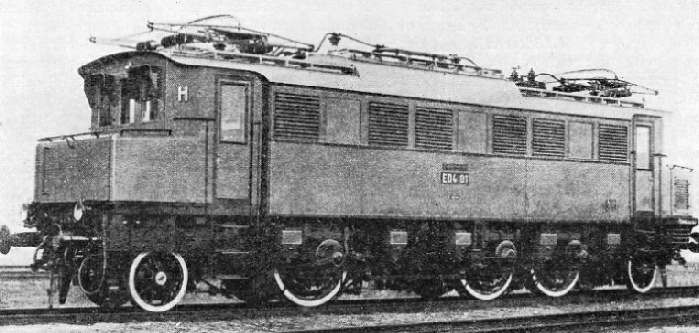
© Railway Wonders of the World 2012-


Part 35


Part 35 of Railway Wonders of the World was published on Friday 27th September 1935.
This issue contained a photogravure supplement on Halls of the Giants. This formed part of an article of the same title, and appeared on pages 1107-1110.
The Cover
The cover this week shows a turn-table worked by the brake apparatus of a locomotive. The appliance consists of a small vacuum engine with two double-acting oscillating cylinders geared to a tractor fixed to the turn-table itself. When an engine is run on the turn-table, the driver connects the vacuum brake pipe of his locomotive to a corresponding pipe on the tractor, and applies the vacuum ejector apparatus. This suction through the brake pipe causes the tractor to work and supplies ample power to turn the engine.
You can read more on Turning Locomotives Round in Cecil J Allen’s Railway Wonders (1925)
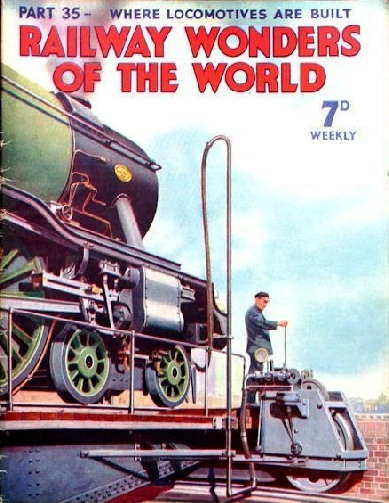
Some Famous Singles (Part 2)
This part takes the story of “singles” down to 1901, when the last “singles” built for a British railway were constructed by the Great Northern Railway. Concluded from part 34.
(Pages 1093-1099 )
Electrification in Europe (Part 1)
Electrification is the best method of handling the intense suburban traffic round modern cities. European countries have made tremendous strides in large electrification schemes. By 1940 it is estimated that some 20,000 route miles of main-line track will be operated by electric locomotives or by electric motor-coach trains. Railway electrification brings prosperity and rapid development. In Sweden, for instance, the forty-six per cent of the railway mileage which is electrified handles eighty-three per cent of the country’s rail traffic. Germany ha about 1,300 route miles electrified, though so far they are divided into six separate sections. The central German plan is an inter-urban schemed, and among the most recently converted lines are the fifty-four miles of double track between Halle and Magdeburg. Italy and Switzerland at present claim the largest amount of electrified track, and after them France has the most important main-line electrification schemes. The article concludes in part 36.
(pages 1121-1124 )
You can read more on “Electric Railways” in Cecil J Allen’s Railway Wonders (1925)
“BULKELEY”
“BULKELEY”, a broad-gauge engine of the famous “Iron Duke” 4-2-2 class built in 1880. This Great Western locomotive had 8 ft driving wheels, cylinders 18 in by 24 in, and a total heating surface 1,750 sq ft. It ceased work in 1892, after it had covered 429,548 miles in service.
(Page 1093)
Rail Transport in Ceylon
The Government-owned railways of Ceylon have been laid over a large part of the island, and to-day there are 951 miles of line, 834 of 5 ft 6 in and 117 of 2 ft 6 in gauge. There is a through service to India, ferry steamers conveying passengers over the twenty-two miles Palk Strait. Although the railway has reached the ancient town of Anuradhapura, not far from the locomotive depot are 2,000 year old temples and shrines, where at each full moon hundreds of worshippers still assemble. This chapter describes a journey taken through a romantic and fascinating country.
(Pages 1100-1105 )
A Sentinel-Cammell Steam Rail Coach
A “SENTINEL-CAMMELL” STEAM RAIL COACH operating on the 5 ft 6 in gauge lines of Ceylon. The seating capacity is fifty-eight third-class and eight first-class passengers. The weight of the coach, including seated passengers and baggage, is 32¾ tons, and its length is 56 ft. The diameter of the wheels is 2 ft 6 in. The six-cylinder engine has a designed output of 130 brake-horse-power.
(Page 1102)
Halls of the Giants
A chapter devoted to the British railway companies’ works, including Swindon, Crewe, Derby, Doncaster and Eastleigh, as well as those of some famous locomotive building firms such as the North British Locomotive Co., and Beyer Peacock & Co. Ltd. The shops where the locomotive frames are machined are themselves interesting. Here huge plates of steel are shaped by oxygen flame-cutters. Science and engineering, indeed, combine in these “Halls of the Giants” where electricity holds sway. Modernity is the watchword in railway works. The “progressive system” on which all mass production is based - the dividing of the work into a number of stages - is used. A 2-6-4 LMS tank engine, built at the Derby Works, contains some 27,000 parts, each of which has to have its precise dimensions. Many of the shops accomplish far more than the building or reconditioning of locomotives. At Derby Works all screws, pins, and rivets are made by a battery of sixteen automatic machines.
(pages 1106-1120 )
You can read more on “How a Locomotive is Built” in Cecil J Allen’s Railway Wonders (1925)
Halls of the Giants:
Photogravure Supplement
READY FOR THE ROAD. A 90-tons three-cylinder “Pacific” engine, built by the North British Locomotive Company for the LNER, lifted by a giant travelling crane on its way out of the erecting shop in Hyde Park Works, Glasgow. Three other “Pacifics” can be seen in various stages of construction. Note the method of lagging the boiler in the foreground with thin sheets over an inner covering of insulation material.
(Page 1107)
A Giant Refreshed
A GIANT REFRESHED. Overhauling the famous “Flying Scotsman” locomotive at the Doncaster Works of the LNER. Locomotive maintenance is an important part of the work in a railway shop, and main line express passenger engines are periodically overhauled. This process consists of stripping, cleaning, and replacing with new components the parts that are worn.
(page 1110)
One of the World’s Fastest Electric Locomotives
ONE OF THE WORLD’S FASTEST ELECTRIC LOCOMOTIVES. This EO4 class locomotive,hauling a train of seven corridor coaches, attained a speed of 94 miles an hour on its test run. The engine was built by the Allgemeine Elektrische Gesellschaft for the German State Railways. The Reichsbahn have over 930 electric locomotives in operation.
(Page 1122)
Contents of Part 35
Some Famous Singles (Part 2)
Rail Transport in Ceylon
Halls of the Giants
Halls of the Giants (photogravure supplement)
Electrification in Europe (Part 1)
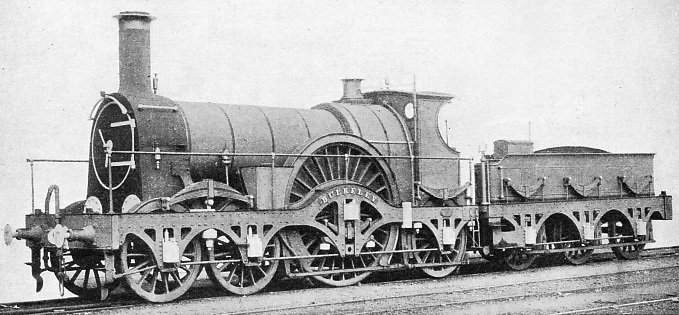
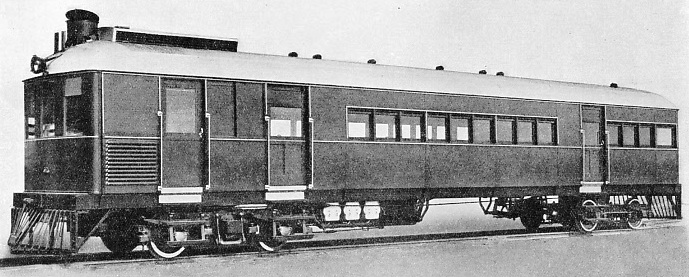
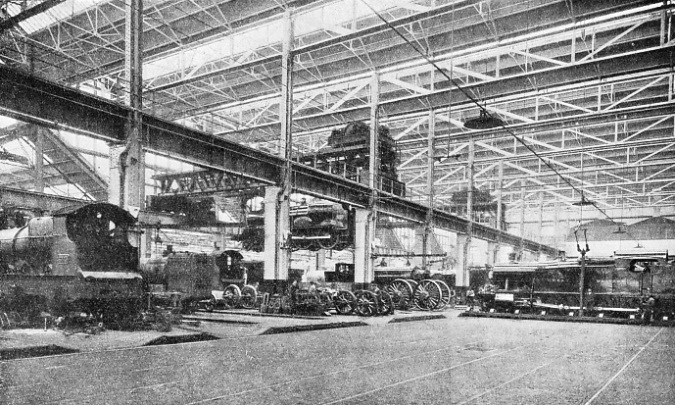
Swindon’s Erecting Shop
SWINDON’S ERECTING SHOP. The locomotives to the left of the picture are standing over the “pits” in process of construction. The express passenger engine suspended from the overhead travelling crane should be noted. On the right is a large Great Western tank locomotive on the electric traverser that runs on rails laid across the shop. The current is supplied to the traverser by two overhead cables, and the collector arms can be seen just over the tank engine’s firebox.
(Page 1102)

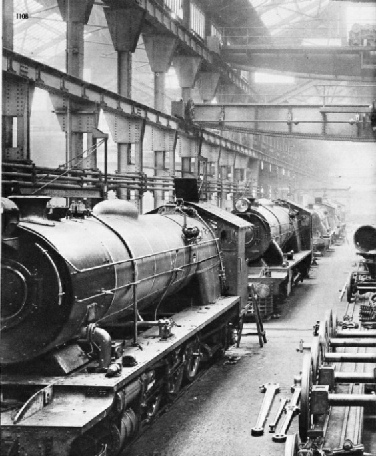
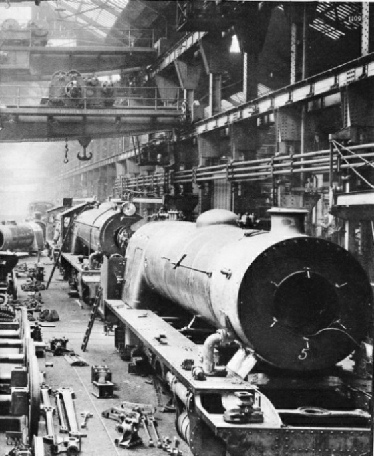
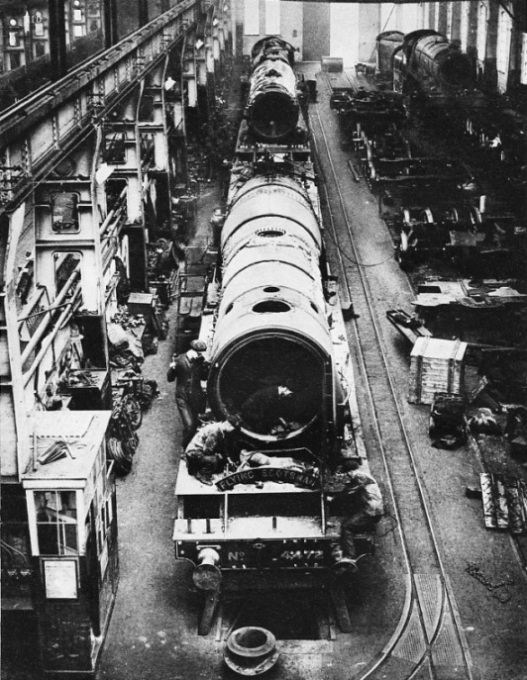
The Erecting Shop of the Vulcan Foundry
IN THE ERECTING SHOP of the Vulcan Foundry at Newton-le-Willows, Lancashire. This general view shows locomotives under construction for service abroad. Over the central multi-gauge track are the wheels of the locomotive seen in the right foreground, with a number of components laid out on either side ready for assembly. The Vulcan Foundry Erecting Shop is 502 ft long and 56 ft wide. Two of the four electric travelling cranes are seen in the picture. The two cranes on the upper gantry are each capable of lifting 50 tons. The capacity of the lower cranes is 35 tons.
(Pages 1108-1109 )
